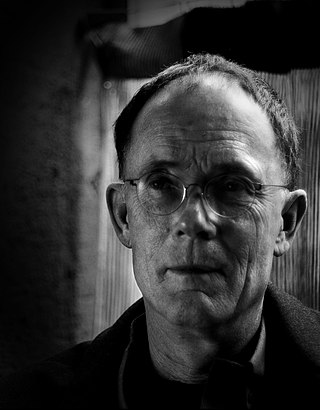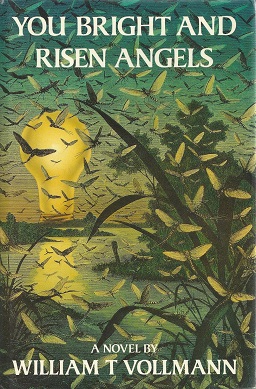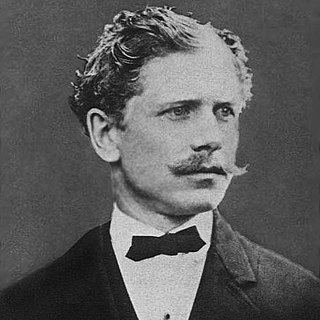Richard David Bach is an American writer. He has written numerous flight-related works of fiction and non-fiction. His works include Jonathan Livingston Seagull (1970) and Illusions: The Adventures of a Reluctant Messiah (1977), both of which were among the 1970s' biggest sellers.

Thomas Ruggles Pynchon Jr. is an American novelist noted for his dense and complex novels. His fiction and non-fiction writings encompass a vast array of subject matter, genres and themes, including history, music, science, and mathematics. For Gravity's Rainbow, Pynchon won the 1973 U.S. National Book Award for Fiction.

William Ford Gibson is an American-Canadian speculative fiction writer and essayist widely credited with pioneering the science fiction subgenre known as cyberpunk. Beginning his writing career in the late 1970s, his early works were noir, near-future stories that explored the effects of technology, cybernetics, and computer networks on humans—a "combination of lowlife and high tech"—and helped to create an iconography for the information age before the ubiquity of the Internet in the 1990s. Gibson coined the term "cyberspace" for "widespread, interconnected digital technology" in his short story "Burning Chrome" (1982), and later popularized the concept in his acclaimed debut novel Neuromancer (1984). These early works of Gibson's have been credited with "renovating" science fiction literature in the 1980s.

Christopher Moore is an American writer of comic fantasy. He was born in Toledo, Ohio. He grew up in Mansfield, Ohio, and attended Ohio State University and Brooks Institute of Photography in Santa Barbara, California.

Samuel Dashiell Hammett was an American writer of hard-boiled detective novels and short stories. He was also a screenwriter and political activist. Among the characters he created are Sam Spade, Nick and Nora Charles, The Continental Op and the comic strip character Secret Agent X-9.

Gravity's Rainbow is a 1973 novel by American writer Thomas Pynchon. The narrative is set primarily in Europe at the end of World War II and centers on the design, production and dispatch of V-2 rockets by the German military. In particular, it features the quest undertaken by several characters to uncover the secret of a mysterious device, the Schwarzgerät, which is slated to be installed in a rocket with the serial number "00000".

William Tanner Vollmann is an American novelist, journalist, war correspondent, short story writer, and essayist. He won the 2005 National Book Award for Fiction with the novel Europe Central.

Postmodern literature is a form of literature that is characterized by the use of metafiction, unreliable narration, self-reflexivity, intertextuality, and which often thematizes both historical and political issues. This style of experimental literature emerged strongly in the United States in the 1960s through the writings of authors such as Kurt Vonnegut, Thomas Pynchon, William Gaddis, Philip K. Dick, Kathy Acker, and John Barth. Postmodernists often challenge authorities, which has been seen as a symptom of the fact that this style of literature first emerged in the context of political tendencies in the 1960s. This inspiration is, among other things, seen through how postmodern literature is highly self-reflexive about the political issues it speaks to.

Timothy McSweeney's Quarterly Concern is an American literary journal, founded in 1998, typically containing short stories, reportage, and illustrations. Some issues also include poetry, comic strips, and novellas. The Quarterly Concern is published by McSweeney's based in San Francisco and it has been edited by Dave Eggers. The journal is notable in that it has no fixed format, and changes its publishing style from issue to issue, unlike more conventional journals and magazines.

Lawrence F. McCaffery Jr. is an American literary critic, editor, and retired professor of English and comparative literature at San Diego State University. His work and teaching focuses on postmodern literature, contemporary fiction, and Bruce Springsteen. He also played a role in helping to establish science fiction as a major literary genre.

The works of William Gibson encompass literature, journalism, acting, recitation, and performance art. Primarily renowned as a novelist and short fiction writer in the cyberpunk milieu, Gibson invented the metaphor of cyberspace in "Burning Chrome" (1982) and emerged from obscurity in 1984 with the publication of his debut novel Neuromancer. Gibson's early short fiction is recognized as cyberpunk's finest work, effectively renovating the science fiction genre which had been hitherto considered widely insignificant.

You Bright and Risen Angels is a 1987 novel by William T. Vollmann, detailing a fictional war between insects and the forces of modern civilization. Vollmann described the book, his first, as "an allegory in part", inspired by his experiences with the mujahedeen in Afghanistan. The novel is subtitled "A Cartoon." It is illustrated by the author.
Marcus Ewert, previously known as Mark Ewert, is an American writer, actor and director, living in San Francisco.

Ambrose Gwinnett Bierce was an American short story writer, journalist, poet, and American Civil War veteran. His book The Devil's Dictionary was named one of "The 100 Greatest Masterpieces of American Literature" by the American Revolution Bicentennial Administration. His story "An Occurrence at Owl Creek Bridge" has been described as "one of the most famous and frequently anthologized stories in American literature", and his book Tales of Soldiers and Civilians was named by the Grolier Club one of the 100 most influential American books printed before 1900.

Michael Hemmingson was a novelist, short story writer, literary critic, cultural anthropologist, qualitative researcher, playwright, music critic and screenwriter. He died in Tijuana, Mexico on 9 January 2014. The reported cause was cardiac arrest.
Steven Moore is an American author and literary critic. Best known as the primary authority on the novelist William Gaddis, he is the author of the two-volume study The Novel: An Alternative History.
Alma Luz Villanueva is an American poet, short story writer, and novelist.

David Foster Wallace (1962–2008) was an American author of novels, essays, and short stories. In addition to writing, Wallace was employed as a professor at Illinois State University in Normal, Illinois, and Pomona College in Claremont, California.

Slow Death is an underground comix anthology published by Last Gasp, the first title published by the San Francisco Bay Area-based press. Conceived as an ecologically themed comics magazine, the title's "underlying theme was always about what the human race was doing to damage the native planet." Frequent contributors to Slow Death included Greg Irons, Jaxon, Dave Sheridan, Richard Corben, Jim Osborne, Tom Veitch, and Dennis Ellefson. Released sporadically from 1970 to 1992, 11 issues were published in all.















